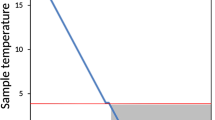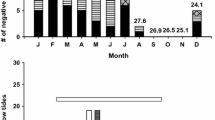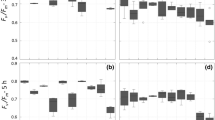Abstract
Differential thermal analysis (DTA) was used to measure the freezing temperature of nine species of red brown intertidal macroalgae from the coast of Maine, USA in 1991. Using slow and rapid cooling rates approximating those found in the field for Ascophyllum nodosum (L.) Le Jol. we found that, for a given rate, the freezing points of all species were similar: -7.06 to -8.02°C for slow cooling (ca. 0.25°C min-1) and -3.42 to -4.56°C for rapid cooling (ca. 5.0°C min-1). In the low shore species, Fucus evanescens C. Ag., photosynthesis was inhibited to a greater extent when plants were frozen or thawed rapidly than after slow freezing or thawing. However, in the upper shore species, F. spiralis (L.), photosynthesis recovered rapidly and completely regardless of freezing rate. Rapidly frozen F. evanescens also experienced greater loss of plasmalemmal integrity, evidenced by a greater loss of cellular contents on re-immersion, than those frozen slowly. Light-limited photosynthesis following freezing was more severely inhibited than light-saturated photosynthesis. Respiration was generally enhanced immediately after freezing, but then declined to rates below those of unfrozen controls within 2 h following re-immersion, with control rates of respiration being achieved after a 24 h recovery period. Our data suggest that the physiological consequences of winter emersion at sub-zero temperatures may vary widely between individual plants of freezing-susceptible species, due to the wide variations in freezing rate associated with microhabitat effects.
Similar content being viewed by others
Literature cited
Bidwell, R. G. S., McLachlan, J. (1985). Carbon nutrition of seaweeds: photosynthesis, photorespiration and respiration. J. exp. mar. Biol. Ecol. 86: 15–46
Bird, C. J., McLachlan, J. (1974). Cold-hardiness of zygotes and embryos of Fucus (Phaeophyceae, Fucales). Phycologia 13: 215–225
Brawley, S. H., Johnson, L. E. (1991). Survival of fucoid embryos in the intertidal zone depends upon developmental stage and microhabitat. J. Phycol. 27: 179–186
Chapman, A. R. O. (1989). Abundance of Fucus spiralis and ephemeral seaweeds in a high eulittoral zone: effects of grazers, canopy and substratum type. Mar. Biol. 102: 565–572
Chapman, A. R. O., Johnson, C. R. (1990). Disturbance and organization of macroalgal assemblages in the Northwest Atlantic. Hydrobiologia 192: 77–121
Davison, I. R. (1991). Environmental effects on photosynthesis: I. Temperature. J. Phycol. 27: 2–8
Davison, I. R., Dudgeon, S. R., Hang-Ming Ruan (1989). Effect of freezing on seaweed photosynthesis. Mar. Ecol. Prog. Ser. 58: 123–131
Davison, I. R., Greene, R. M., Podolak, E. J. (1991). Temperature acclimation of respiration and photosynthesis in the brown alga Laminaria saccharina. Mar. Biol. 110: 449–454
Davison, I. R., Reed, R. H. (1985). Osmotic adjustment in Laminaria digitata (Huds.) Lamour. (Phaeophyta) with particular reference to seasonal changes in internal solute concentrations. J. Phycol. 21: 41–50
Day, R. W., Quinn, G. P. (1989). Comparisons of treatments after an analysis of variance in ecology. Ecol. Monogr. 59: 433–463
Dowgert, M. F., Wolfe, J., Steponkus, P. L. (1987). The mechanics of injury to isolated protoplasts following osmotic contraction and expansion. Pl. Physiol. 83: 1001–1007
Dring, M. J., Brown, F. A. (1982). Photosynthesis of intertidal brown algae during and after periods of emersion: a renewed search for physiological causes of zonation. Mar. Ecol. Prog. Ser. 8: 301–308
Dudgeon, S. R., Davison, I. R., Vadas, R. L. (1989). Effect of freezing on photosynthesis of intertidal macroalgae: relative tolerance of Chondrus crispus and Mastocarpus stellatus (Rhodophyta). Mar. Biol. 101: 107–114
Dudgeon, S. R., Davison, I. R., Vadas, R. L. (1990). Freezing tolerance in the intertidal red algae Chondrus crispus and Mastocarpus stellatus: relative importance of acclimation and adaptation. Mar. Biol. 106: 427–436
Edelstein, T., McLachlan, J. (1975). Autecology of Fucus distichus ssp. distichus (Phaeophyceae: Fucales) in Nova Scotia, Canada. Mar. Biol. 30: 305–324
Frazer, A. W. J., Brown, M. T., Bannister, P. (1988). The frost resistance of some littoral and sub-littoral algae from southern New Zealand. Bot. Mar. 31: 461–464
George, M. F., Burke, M. J., Weiser, C. J. (1974). Supercooling in overwintering Azalea buds. Pl. Physiol. 54: 29–35
George, M. F., Becwar, M. R., Burke, M. T. (1982). Freezing avoidance by deep undercooling of tissue water in winter-hardy plants. Cryobiology 19: 628–639
Grime, J. P. (1979) Plant strategies and vegetation processes. Wiley & Sons, New York
Grout, B. W. W. (1987). Higher plants at freezing temperatures. In: The effect of low temperatures on biological systems. Edward Arnold, London, p. 293–314
Kanwisher, J. W. (1957). Freezing and drying in intertidal algae. Biol. Bull. mar. biol. Lab., Woods Hole 113: 275–285
Kerby, N. W., Raven, J. A. (1985). Transport and fixation of inorganic carbon by marine algae. Adv. bot. Res. 11: 71–123
Luning, K. (1990). Seaweeds: their environment, biogeography and ecophysiology. John Wiley & Sons, New York
Parker, J. (1960). Seasonal changes in cold-hardiness of Fucus vesiculosus. Biol. Bull. mar. biol. Lob., Woods Hole 119: 474–478
Reed, R. H., Davison, I. R., Chudek, J. A., Foster, R. (1985). The osmotic role of mannitol in the Phaeophyta: an appraisal. Phycologia 24: 35–47
Rice, E. L., Chapman, A. R. O. (1985). A numerical taxonomic study of Fucus distichus (Phaeophyta). J. mar. biol. Ass. U.K. 65: 433–459
Rosen, M. (1957). A modified ninhydrin colorimetric analysis for amino acids. Archs Biochem. Biophys. 67: 10–15
Santarius, K. A. (1990). Freezing of isolated thylakoid membranes in complex media. VI. The effect of pH. Cryobiol. 27: 547–561
Siminovitch, D., Cloutier, Y. (1983). Drought and freezing tolerance and adaptation in plants: some evidence of near equivalences. Cryobiol. 20: 487–503
Somerville, C., Browse, J. (1991). Plant lipids: metabolism, mutants, and membranes. Science, N.Y. 252: 80–87
Steponkus, P. L. (1990). Cold acclimation and freezing injury from a perspective of the plasma membrane, In: Katterman, K. (ed.). Environmental injury to plants. Academic Press, New York, p. 1–16
Steponkus, P. L., Lynch, D. V. (1989). Freeze/thaw-induced destabilization of the plasma membrane and the effects of cold acclimation. J. Bioenerg. Biomembr. 21: 21–41
Author information
Authors and Affiliations
Additional information
Communicated by J. Grassle, New Brunswick
Rights and permissions
About this article
Cite this article
Pearson, G.A., Davison, I.R. Freezing rate and duration determine the physiological response of intertidal fucoids to freezing. Marine Biology 115, 353–362 (1993). https://doi.org/10.1007/BF00349832
Received:
Accepted:
Issue Date:
DOI: https://doi.org/10.1007/BF00349832




